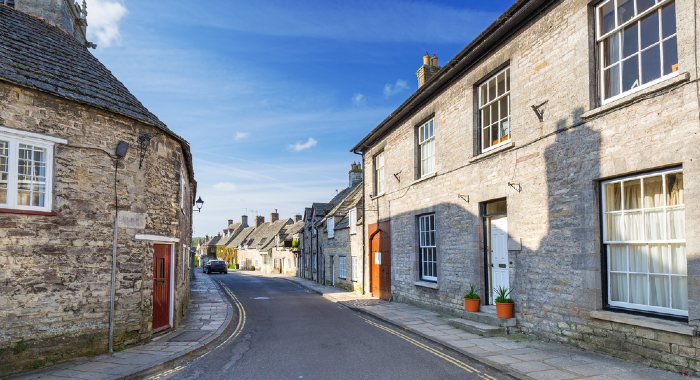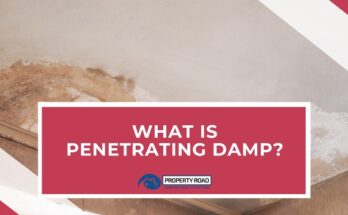External wall insulation can be a great way to improve the thermal efficiency of your property and reduce your energy bills.
However, problems can occur if it is not installed correctly.
But since insulating an external wall can prevent up to 40% of the heat lost from a property, it is worth considering.
For the investment, you will have a home with no draughts, a fresh exterior appearance, and lower heating bills.
Not only will you see your home’s energy rating improve – but there could also be a 10% boost in your home’s value.
Here, the Property Road team takes a closer look at the pros and the problems with external wall insulation, which will help if you:
- Are looking to buy a property that already has it
- Want to add it to your existing property
What is external wall insulation?
External wall insulation is a system used to insulate the external walls of a property.
It is usually applied to properties with solid walls; however, it can also be used on properties with cavity walls – see below.
The insulation material is applied to the outside of the property and is held in place with either adhesive or mechanical fixings. A render or cladding is then applied over the top of the insulation to provide a weatherproof finish.
Why would you have external wall insulation?
There are several reasons why you might want to have external wall insulation installed on your property, such as:
Improving your home’s thermal efficiency
This can help to reduce your energy bills as you will need to use less heating and hot water to maintain a comfortable temperature inside.
Reduce noise pollution
The insulation can help reduce the amount of noise that comes into your property from outside, making it more peaceful and quieter.
Improve the appearance of your property
Having insulation can give your property a facelift as it can be finished in a variety of colours and finishes.
What are the advantages of external wall insulation?
External wall insulation has pros and cons – here are some of the advantages:
- Reduces heat loss and energy bills
- Fewer draughts
- No disruption when being installed
- Does not reduce the internal floor area
- Insulated walls will contribute to thermal mass (also known as the ‘tea cosy’ effect)
- Improves weatherproofing and sound resistance
- Boosts the life of the wall
- Reduces condensation on internal walls
- More suitable for the English climate than internal insulation (Xu et al., 2019)
What are the disadvantages of external wall insulation?

Having looked at the advantages, the problems with external wall insulation include:
- It can be difficult to install
- If not installed correctly, it can cause damp problems
- It can be expensive
Common problems include damp patches appearing on walls, mould growth, and cracking or bulging of the render or brickwork.
Problems can also occur if the insulation is not properly protected from the weather, or if it is installed on a property that is not suitable for it.
To avoid problems with external wall insulation, it is important to choose a reputable installer who has experience in installing this type of insulation.
It is also important to make sure that the property is suitable for external wall insulation, and that all precautions are taken to protect the insulation from the weather.
So, when weighing up the pros and cons, insulating your external wall is a good option if you are looking to improve the thermal efficiency of your property.
However, it is important to ensure that it is installed correctly to avoid potential problems.
What are the common problems with external wall insulation?
External wall insulation can cause several problems, including:
Water ingress
Water ingress is often the biggest problem with external wall insulation, as it can lead to serious structural damage. It is important to make sure that the insulation is properly installed and that any gaps are sealed.
Structural damage
Structural damage can also be caused by the insulation if it is not installed properly.
Thermal bridging
Thermal bridging can occur if the insulation is not installed correctly, and this can lead to heat loss and cold spots on the property.
Condensation and mould growth
Condensation can also be a problem with insulation, as it can cause mould growth. It’s even more impactful than you think.
It is important to ensure that the property is well ventilated to lessen the instances of this happening.
You can also use thermal lining paper in problem areas as we did in our Wallrock thermal liner review.
Fire safety
Fire safety is another important consideration when installing external wall insulation. It is important to make sure that the insulation does not block any fire exits or windows.
While insulating a property’s external wall can cause several problems, it is important to note that these can be avoided if the insulation is installed properly.
How much does external wall insulation in the UK cost?

The cost will vary depending on the size of the property and the type of insulation that is used. It is important to get a few quotes from different companies before deciding.
- For a three-bedroom semi-detached home, the cost is likely to be in the range of £5,000-£9,000
- Larger detached homes could cost £8,000-£15,000 and there are specialist systems that come with a higher price tag, but there are also cheaper options available from builders’ merchants
Either way, scaffolding will need to be erected, and all pipes and cables fixed to the wall will need to be removed and replaced – costs that can’t be avoided.
How much could I save fitting external wall insulation?
Along with making your property warmer, there are some big energy bill savings to be enjoyed when fitting external wall insulation. For example:
- A detached home could save £425 per year
- A semi-detached home could save £255 per year
- A bungalow could save £170 per year
- A mid-terraced property could save £160 per year
- A mid-floor flat could save £125 per year
These cost savings provided by the Energy Trust are based on insulating a home with gas heating.
Does external wall insulation need planning permission?
It’s important that you check with your local planning authority because external wall insulation will change your home’s external appearance.
For those properties, this means having planning permission, and you should begin this process before approaching insulation firms.
You also need to understand that if your home is a listed building or in a conservation area, then it’s unlikely that you will get planning consent.
However, in most cases, the installation of external wall insulation for a domestic property will be classed as a permitted development, so you should have no problems.
Will external wall insulation cause damp problems?
As we will see later in this article, there is a potential issue with external wall insulation causing damp problems in your home. In fact, a study on Swedish properties concluded that the type of external wall insulation even influenced mould growth and instances of moisture damage (Hamid et al., 2024).
Moisture may enter either from the external wall when it rains, for example, or from the activities that are undertaken within a property on the internal wall, for example, washing, cooking, and drying clothes.
Since most homes have cavity walls and are likely to have cavity wall insulation, you need to appreciate that before this housebuilding development, builders had to choose whether to build either:
- A wall that would prevent moisture on both skins (i.e. impermeable)
- A breathing wall, so moisture will penetrate – and then be evaporated away
It’s important to understand that builders installing a solid brick wall will usually tend towards building an impermeable one, while a stone wall usually tends to be a breathing one.
In comparison, for homes with a cavity wall, this will be impermeable since the cavity creates a barrier that will prevent any moisture from penetrating the inner wall and the home since any rainwater that enters will be evaporated by the cavity’s air movement.
Also, the insulation materials used today will be clad or rendered to your home to help prevent rainwater from penetrating. However, it’s still important to look into them. For example, external wall insulation materials such as mineral wool or rockwool are still permeable (Vololonirina & Perrin, 2014).
While these materials work to prevent water ingress, they don’t stop any moisture from reaching the wall’s internal surface, so you may need to consider improving your property’s ventilation to move any moist air to prevent damp problems.
I have solid stone walls; can I use external wall insulation?

For anybody with a property that has solid stone walls and wants to know whether you can install external wall insulation, then the answer is yes.
Also, some homes with a solid stone wall may have a small cavity between the interior and exterior wall that is filled with rubble.
So, any moisture that forms within the cavity will either evaporate away because of the air movement.
It is also worth considering that a stone wall will usually be a ‘breathing wall’ and you need to maintain the breathability that will ensure the wall operates as it is designed to do.
Essentially, you’ll need to use natural insulation such as cork or wood fibre and use lime as the external render.
For a solid brick wall, which type of external wall insulation is best?
Need to know which type of external wall insulation is best? Then check your bricks.
That’s because not all bricks are the same since the permeability and the quality of them will vary.
For example, it is fairly common to see bricks that are ‘spalling’, that is a brick with its surface flaking off.
This tends to happen because, in the freeze-thaw process, the moisture that penetrates a brick will freeze, and when it thaws, this will lead to flaking.
As such, external wall insulation will probably not have much impact on the wall’s performance – except to improve the thermal performance.
I have cavity walls; can I use external wall insulation?
We have already seen that a cavity wall will usually be ventilated which is why builders create the cavity in the first place.
So, any warmth from the property that penetrates the internal wall to enter the cavity will then be exhausted by the cavity’s ventilation.
This then means that installing external wall insulation will not have much of an effect since most of the heat lost will disappear in the cavity before reaching the external skin.
Perhaps one issue to consider is that if the external skin enables rainwater to penetrate into the cavity, you should consider external insulation and use a render that is weatherproof to help stop the rainwater from entering and boost the wall’s thermal barrier.
How long will external wall insulation last?
Depending on the installer, most manufacturers offer a warranty of 25 years, but the insulation has to be installed correctly.
This is a minimum term, so you should expect your insulation to last longer than that.
There shouldn’t be any problems with external wall insulation if it has been protected from the weather so a waterproof final render coating will be crucial.
If you need to contact installers of external wall insulation, the National Insulation Association has a list.
Other External wall insulation FAQs
How much difference does external wall insulation make?
The difference that the insulation will make to your property depends on several factors, such as:
- The type of material used
- How well the insulation is installed
- The type of property you have
What is the best insulation for outside walls?
Several different types of insulation material can be used, including:
- Polystyrene (EPS)
- Polyurethane
- Phenolic resin (K5)
- Mineral wool
- Wood fibre
Each type of insulation has its own benefits and drawbacks, so it is important to choose the right one for your needs. For example, polystyrene is a good choice if you are looking for a lightweight insulation material, but it is not as durable as other options.
Can too much external wall insulation cause condensation?
If the insulation is too thick or not installed correctly, it can cause condensation to form on the inside of the property. This can lead to damp problems and is something you should be aware of before installing external wall insulation.
Can external wall insulation damage health?

There is no evidence to suggest that external wall insulation can damage health. However, it is important to make sure that the property is well ventilated to prevent condensation and mould growth.
Is it difficult to get planning permission for external wall insulation?
Planning permission is not usually required for external wall insulation. However, it is always best to check with your local planning authority before starting any work – especially if it drastically changes the appearance of your home.
How to find reputable companies?
There are several ways to find reputable companies that can carry out external wall insulation. One way is to ask friends or family if they have used a company before. Another way is to search online for customer reviews. Finally, it is always best to get a few quotes from different companies before deciding. Also, don’t forget to check online reviews.
Problems with internal wall insulation
It’s also worth noting that there are issues to consider for problems with internal wall insulation, including:
- It can be difficult to install in older properties
- The installation process can be disruptive
- Might not be suitable for listed buildings or those in conservation areas
We mentioned earlier the problems with cavity wall insulation, and these could include:
- If the property is not properly ventilated, there is a risk of condensation and mould growth
- If the cavity wall insulation is installed incorrectly, it can cause problems such as damp patches on walls or a decrease in the property’s thermal efficiency
- The cavity wall insulation process can also be disruptive
If you need to decide between insulating your home with either internal, external, or cavity wall insulation, you really should speak with experts to calculate the costs, the amount of disruption – and the downsides – before committing yourself.
What are the problems with external wall insulation?
External wall insulation can provide several benefits to your property, but it is important to make sure that it is installed correctly to avoid any problems.
If you are thinking about insulating your external walls, you must use a professional company with a sound reputation. For the money, it’s important to do your research and ensure you don’t waste money – or face the prospect of having to remove the insulation.




